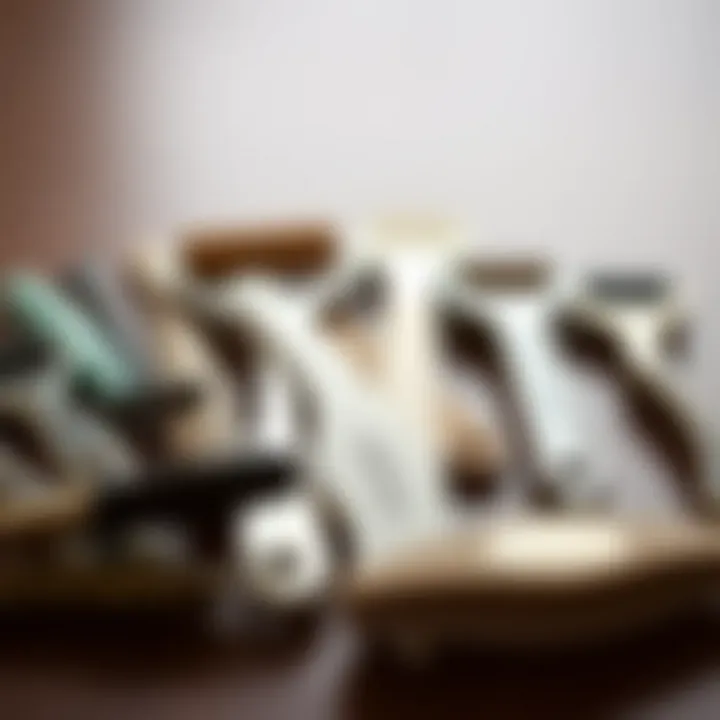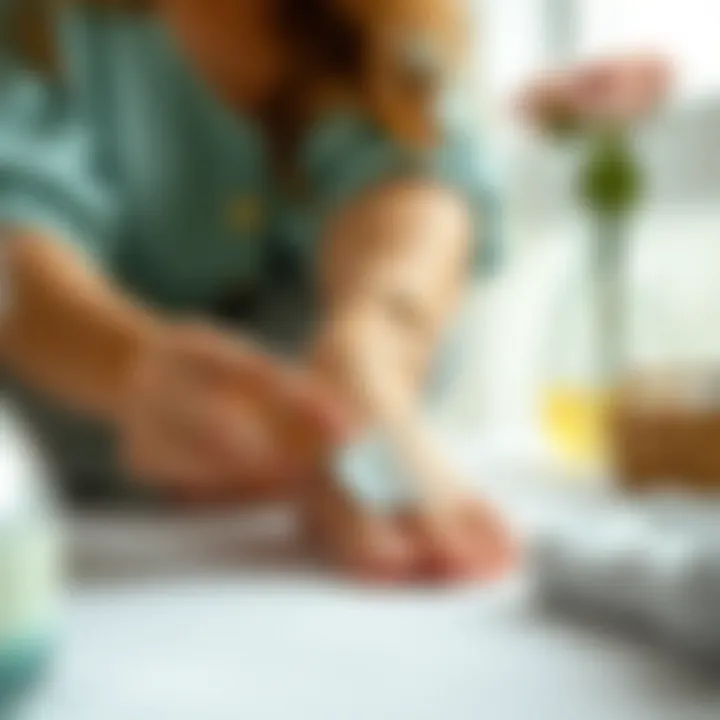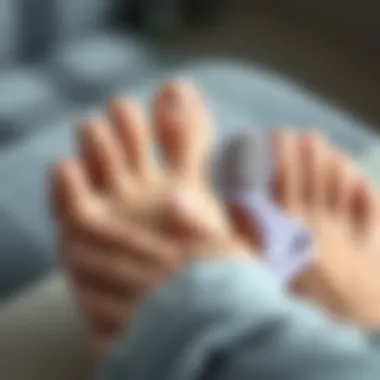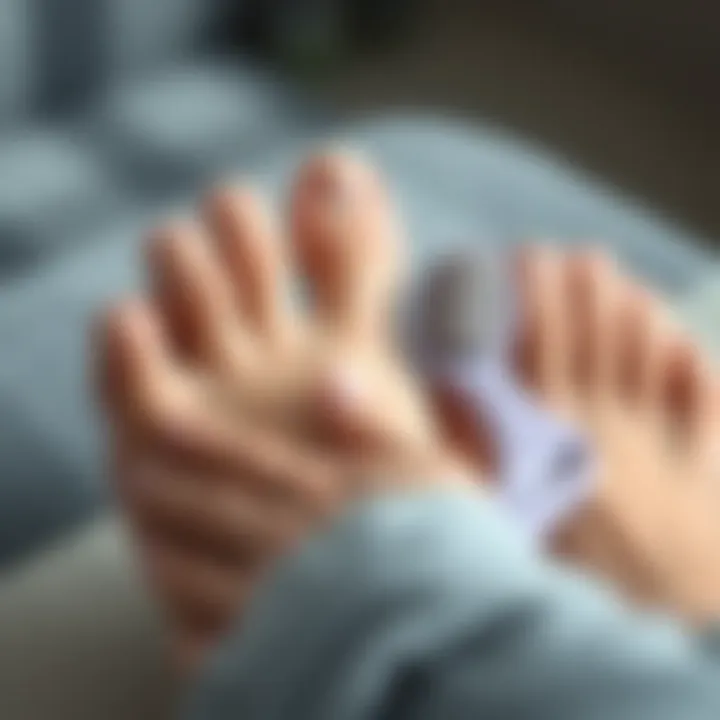Discovering the Pedicure Scraper Tool for Foot Care


Intro
In a world where self-care is becoming a priority for many, the importance of proper foot maintenance cannot be overstated. The pedicure scraper tool, often overlooked, plays a crucial role in this aspect of personal grooming. This simple yet effective instrument removes dead skin and enhances the appearance of feet, making it a staple for anyone serious about foot care.
Just as one would not neglect skincare or haircare, maintaining one's feet demands equal attention. Regular use of a pedicure scraper can lead to healthier, smoother feet. It's not only about aesthetics; it's also about hygiene. Feet endure a lot throughout the day, and treating them with care can prevent potential health issues. By discussing the various types of pedicure scrapers, their uses, and care practices, this article aims to shed light on an often underestimated tool in foot care.
In addition to tackling the nitty-gritty of functionality and maintenance, we'll also address safety measures to take when using these tools, particularly for those who might be new to foot care routines. Whether you're a professional pedicure specialist or just someone wanting to improve their at-home foot regimen, this exploration promises insights that could enhance both technique and results.
With a firm understanding of what the pedicure scraper can do, one can elevate their foot care routine, ensuring that these often-neglected extremities receive the attention they deserve.
Understanding the Pedicure Scraper Tool
When it comes to foot care, one cannot overlook the significance of the pedicure scraper tool. This humble yet essential device plays a crucial role in maintaining foot hygiene and enhancing overall aesthetics. A well-maintained foot not only looks appealing but also contributes to one's health. The idea is simple but often overlooked: regular attention to your feet can prevent uncomfortable conditions and elevate your grooming routine.
Definition and Purpose
A pedicure scraper tool is designed primarily to exfoliate the feet. It targets rough patches and thickened skin, effectively reducing calluses and dead skin that tend to build up, especially under the heels and balls of the feet. Some might use it simply for aesthetic reasons; others may find that regular use softens their feet, yielding more comfortable footwear experiences.
The purpose extends beyond mere beauty. The act of scraping helps improve blood circulation in the feet, not to mention it can prevent potential foot ailments. Think about it: how often do people overlook their feet, only to suffer later on with discomfort or pain? By integrating a pedicure scraper into your foot care regimen, you’re taking proactive steps towards better foot health—a step worth taking.
History of Foot Care Tools
The journey of foot care tools is rich and interesting. Foot care tools have been documented as far back as ancient Egypt, where individuals used rudimentary stone scrapers to maintain their feet. These early tools predate modern materials and designs, but the principle remains the same: get rid of the unwanted layers to reveal healthy skin beneath.
Over centuries, various cultures developed their own versions of foot care implements, adapting materials that ranged from wood to metal. In the Victorian era, foot care became a more social affair, and specialized tools began to gain popularity; however, it wasn't until the 20th century that foot care saw a boom in commercially available scrapers and other tools.
Today, pedicure scrapers come in different shapes and materials, each tailored for various levels of foot care. Metal scrapers remain popular for their durability, while plastic versions offer a gentler option for sensitive skin. There's even a budding trend for electric scrapers that provide an easy, effective way to maintain foot health with minimal effort. This evolution highlights not just advancements in material sciences but also an increasing awareness of the importance of foot care in our daily lives.
In sum, understanding the pedicure scraper tool is not just about knowing what it is; it’s about appreciating its role in personal care history and recognizing the ongoing relevance it holds in today's world. So next time you see that tool in your kit, remember: it’s much more than a routine item. It’s a key to your well-being.
Types of Pedicure Scraper Tools
When it comes to foot care, the type of pedicure scraper tool you use can make all the difference. Each variety has its own unique characteristics that cater to specific needs, thus enhancing not only your foot hygiene but also your overall grooming routine. Understanding these differences is crucial for anyone looking to maintain healthy and aesthetically pleasing feet.
Metal Scrapers
Metal scrapers are perhaps the most traditional type of pedicure scraper available. These tools, often made of stainless steel, offer durability and effectiveness in their design. One of the prime advantages of metal scrapers is their ability to tackle tough calluses with precision. The sharp edges can cut through even the thickest skin on your feet, making them particularly useful for individuals who struggle with excessive hard skin.
However, it's vital to wield metal scrapers with caution. Improper use can lead to injuries, such as cutting or irritating the skin. A helpful tip is to soak your feet beforehand, as this softens the skin and makes scraping safer and more effective.
Ceramic Scrapers
Ceramic scrapers bring an elegant twist to foot care. Known for their smooth finish, these tools glide easily over the skin without causing irritation. Unlike metal scrapers, they are less aggressive, making them suitable for delicate skin. People with sensitive feet will find ceramic scrapers particularly beneficial; they can reduce the risk of nicks and cuts.
Moreover, ceramic materials are easy to clean and maintain. Many users appreciate their aesthetic appeal, as they can often be found in various colors and designs. A downside, however, is that they may not be as effective on very tough calluses compared to their metal counterparts. Ultimately, ceramic scrapers suit those who prioritize gentleness in their foot care routines.
Plastic Scrapers
Plastic scrapers might not originally come to mind when one thinks of effective foot care tools, yet they hold their ground in several instances. These scrapers are lightweight, portable, and generally less expensive compared to metal or ceramic options. Their design typically features better grip and safety, which is appealing for novies in foot care.
However, the downside is that plastic scrapers may require more effort to achieve desired results on persistent hard skin. They work well for regular maintenance rather than intensive callus removal. If you’re maintaining foot hygiene in between salon visits, a plastic scraper could be just what you need. Just remember to choose one made of high-quality plastic to avoid breakage during use.


Electric Scrapers
For those who prefer modern solutions to foot care, electric scrapers are a game changer. These devices often come equipped with rotating heads that make quick work of rough skin. Their efficiency is one of their main draws; you can achieve smooth feet in a fraction of the time compared to manual scraping methods. Furthermore, many electric scrapers have adjustable settings, allowing users to tailor the intensity to their comfort level.
Nevertheless, electric scrapers may come with a steeper price tag and can require batteries or charging, which is something to consider. Users should also take care to follow instructions to avoid over-exfoliating, as the power can lead to skin irritation if not handled correctly.
Benefits of Using a Pedicure Scraper Tool
Using a pedicure scraper tool is not just a luxury; it’s a vital aspect of maintaining healthy and aesthetically pleasing feet. The importance of this tool lies in its multifaceted benefits. Foot care isn't merely about looks, though that plays a significant role; it’s deeply intertwined with overall hygiene and health. Regular use of a scraper can help keep your feet in tip-top shape, preventing various problems that could arise from neglecting foot maintenance. Let’s unpack these benefits and see how they can enhance your grooming routine.
Improving Foot Hygiene
When it comes to foot hygiene, a pedicure scraper can be a game changer. Often, our feet end up being the unsung heroes of our day-to-day lives, crammed in shoes and often overlooked in our grooming routines. However, dead skin, calluses, and dirt can accumulate on the soles, not only leading to an unpleasant odor but also contributing to various foot issues.
By incorporating a pedicure scraper into your regimen, you can effectively remove this buildup. This not only aids in keeping the skin clean and fresh but can also minimize the risk of infections. After a thorough scraping session, your feet will feel rejuvenated, and you'll likely notice a significant reduction in foot odor over time. It's essential to note that clean feet can contribute to overall health by preventing conditions such as athlete's foot, which thrives in damp, neglected environments.
Enhancing Aesthetic Appeal
Who doesn’t want their feet to look their best? A well-groomed appearance can be a confidence booster, particularly during sandal season. Using a pedicure scraper tool helps reveal the smooth skin underneath layers of dead, flaky cells. Picture this: smooth heels and polished toes, ready to flaunt regardless of occasion.
As you scrape away that outer layer, you’re not only improving hygiene but also enhancing the visual appeal of your feet. Regular use can lead to softer, more appealing feet and can even make applying nail polish a breeze—who doesn’t want a perfect canvas? Moreover, in the eyes of fashion enthusiasts and designers, beautifully maintained feet can elevate an outfit, contributing to a polished look.
Preventing Foot Conditions
Preventative care should always be a priority in health, and the same applies to our feet. The consistent use of a pedicure scraper can help fend off various foot conditions that may arise from neglect. Calluses and corns can develop due to pressure and friction, and while they may not initially seem harmful, left unattended, they can lead to discomfort or pain.
Furthermore, a buildup of hard skin can limit mobility and increase the risk of conditions like plantar fasciitis. Regular scraping encourages healthier skin growth and can significantly reduce the chances of developing such issues. Therefore, integrating a pedicure scraper into your foot care routine is a proactive step that shields against potential problems.
In summary, the benefits of using a pedicure scraper tool are clear—improved hygiene, enhanced aesthetics, and preventative care all play vital roles in maintaining healthy feet. As you consider your foot care routine, remember that healthy feet can lead to a healthier you. Your feet deserve the same attention you give to the rest of your body.
Proper Technique for Using a Pedicure Scraper Tool
Utilizing a pedicure scraper tool properly is critical for maintaining foot health and appearance. The right technique ensures not just effectiveness but also safety during the scraping process. An improper approach can lead to injuries and skin irritation, which is the opposite of what you wish to achieve. Let's delve into the preprocessing steps, the actual scraping technique, and the aftercare needed to create the ultimate foot care routine.
Pre-Pedicure Preparations
Before diving into the scraping process, make sure you're fully prepared. Here’s how to set the stage:
- Gather Your Materials: Have everything you need within arm's reach. This includes your preferred pedicure scraper, foot soak solution, a towel, and moisturizing lotion. Being organized helps you stay relaxed.
- Foot Soaking: Soaking your feet in warm, soapy water for about 10 to 15 minutes is essential. This softens the calluses and hard skin, making it easier for the scraper to work its magic without excessive force.
- Choose the Right Environment: Find a quiet, comfortable place to sit down. Ensure you have adequate light to see your feet clearly. A well-lit area helps reduce the chances of accidental nicks and scrapes.
Setting the right atmosphere contributes significantly to the ease of your foot care routine. A few simple preparations can provide a smooth experience.
Steps for Efficient Scraping
Once your feet are prepped, it's time to get to the nitty-gritty of proper scraping. Follow these steps for an effective approach:
- Hold the Scraper Correctly: Grip the scraper firmly but comfortably. Position it at an angle that feels natural for your hand. Too much pressure can lead to injuries, so use a light touch at first.
- Scraping Technique: Start at the heel and work your way toward the toes. Use steady, short strokes, applying minimal pressure. It's better to go slowly and build up to the desired smoothness than to rush and risk damaging the skin.
- Check for Progress: Periodically check your work. Wipe away the dead skin with a dry towel to see what you've scraped away. This assessment helps you avoid overscraping and encourages an even finish.
- Switch Directions: If you're working on particularly stubborn patches of skin, shifting the angle of the scraper can minimize strain and improve efficiency.
- For areas with thicker skin, like the balls of your feet, you may apply a bit more pressure, but always remain gentle.
By following these steps and staying focused, you will enhance your foot care routine significantly.


Post-Scraping Care
After you've completed the scraping, it’s vital to care for your feet properly. Here’s what you need to do:
- Rinse Your Feet: Wash away any debris and flakes of skin left over from the scraping. A gentle rinse with lukewarm water is adequate. This step refreshes your feet and prepares them for nourishment.
- Moisturize: Apply a thick layer of foot cream or lotion to hydrate your skin. Ingredients like shea butter or coconut oil can nourish and repair the skin barrier. Massaging the lotion in also stimulates circulation, which is a nice bonus.
- Protect the Skin: If you've scraped more aggressively, consider wearing socks for a few hours to trap in moisture and protect your newly treated skin. Going barefoot or exposing your feet to harsh surfaces immediately after can undo all your hard work.
- Regular Maintenance: Incorporate scraping into your grooming routine at regular intervals to keep your feet in top condition. The more consistent you are, the less buildup there will be to tackle in each session.
Remember, the key to effective foot care is patience and consistency!
Following these detailed steps ensures that you can enjoy the therapeutic benefits of smoothing your feet while minimizing the potential for injury. By integrating these techniques into your personal grooming ritual, you can significantly enhance the health and look of your feet.
Safety Considerations
When it comes to foot care, implementing safe practices is as vital as the tools you use. While the pedicure scraper tool can be an effective instrument for maintaining foot hygiene and aesthetics, improper use can lead to injuries or complications. In this section, we emphasize the importance of safety when handling pedicure scrapers, addressing both preventative measures and insight into when to seek professional help.
Avoiding Injuries
To harness the full benefits of a pedicure scraper, it's crucial to steer clear of potential injuries. Here are some essential practices to consider:
- Choose the Right Tool: Depending on your skin type and foot condition, selecting the appropriate scraper is critical. For instance, someone with sensitive skin might want to avoid metal scrapers, opting for softer options like ceramic or plastic instead.
- Inspect for Damage: Before using your scraper, check for any signs of wear and tear. A chipped or worn scraper can cause more harm than good, increasing the risk of cuts and abrasions.
- Use Gentle Pressure: Applying too much force can lead to skin damage. Be sure to use light, smooth strokes to remove dead skin without causing pain.
- Keep it Clean: Hygiene goes both ways. Ensure your scraper is washed after each use with warm soapy water to prevent infections. Use alcohol wipes for more thorough sanitation, especially if you have any cuts or blisters on your feet.
By paying attention to these simple yet effective strategies, you can minimize risks significantly while reaping all the benefits of the pedicure scraper tool.
When to Seek Professional Help
Sometimes, even the best-laid plans go awry, and you may find yourself needing assistance. Here’s when to consider consulting with a professional:
- Persistent Pain: If you experience prolonged discomfort or pain while using the scraper, it could signify an underlying issue that needs addressing. Ignoring pain can lead to complications down the line.
- Signs of Infection: Redness, swelling, or discharge around a scraping area may indicate infection. Seeking medical attention can help prevent more serious health issues from developing.
- Severe Calluses or Corns: While scrapers are designed to tackle mild callusing, excessive buildup may warrant professional intervention. A podiatrist can provide specialized treatments that go beyond what home care can achieve.
- Foot Conditions: If you have preexisting conditions such as diabetes, psoriasis, or eczema, it is wise to consult healthcare providers before engaging in any foot care regimen. They can offer tailored advice geared toward your specific needs.
Being mindful of these pointers can guide individuals to make informed decisions about their foot care routine. Prioritizing safety not only promotes better hygiene but also preserves overall foot health for the long term.
Integrating the Tool into Personal Grooming Routines
Incorporating a pedicure scraper tool into personal grooming routines is more than just a trendy choice; it's a proactive step in ensuring healthy and beautiful feet. When we talk about personal grooming, it's essential to realize that foot care often takes a backseat. We might splurge on skincare products for our face or invest in fancy haircuts, but our feet, bearing our weight day in and day out, deserve equal attention. Embracing the use of a pedicure scraper tool can elevate the overall quality of your foot care regimen.
Integrating this tool means developing a routine that emphasizes foot hygiene and aesthetics. Foot scrapers help remove dead skin cells and calluses, which can build up over time and not only detract from the appearance of our feet but also lead to discomfort and various foot conditions. Let's unpack how this tool can fit snugly into your grooming routine.
Home Pedicure Techniques
Utilizing a pedicure scraper starts with understanding how to properly incorporate it in your home pedicure techniques. Here’s a simple step-by-step guide:
- Soak Your Feet: Begin with a relaxing soak in warm, soapy water. This step helps to soften the skin and makes it susceptible to scraping.
- Gentle Scraping: After your feet are adequately soaked, take your pedicure scraper and gently glide it over the areas with rough patches. Keep an eye on the pressure used; you want to avoid injuries or cuts. It's about finesse, not force.
- Scrape in One Direction: Move in one direction to prevent tearing the skin. This method not only enhances effectiveness but also minimizes the risk of causing abrasions.
- Moisturize Post-Scraping: Once you’ve achieved the desired smoothness, apply a generous amount of moisturizer. This seals in hydration and leaves your skin feeling supple. Products with shea butter or coconut oil are especially nourishing.
By following these home pedicure techniques, you'll turn a simple foot care task into a more routine ceremony of self-care that you look forward to.
Complementary Foot Care Products
To maximize the benefits of using a pedicure scraper tool, pairing it with the right complementary foot care products can make all the difference. Here's a breakdown that combines efficiency with indulgence:
- Foot Exfoliator: Use foot scrubs containing exfoliating agents like salicylic acid or alpha hydroxy acids to remove old skin before scraping. This ensures your scraper performs at its best.
- Moisturizers: After your scraping session, reach for a thick cream to nourish your feet. Products that include ingredients like urea or lanolin can hydrate effectively.
- Foot Masks: Treat your feet to occasional masks—think of them as spa treatments at home. These masks usually provide deep conditioning and can keep cracked heels at bay.
- Nail Care Products: Don’t forget to give your nails some love. Nail oils or hardeners can strengthen and protect the nail bed, enhancing the overall look of your feet.
By integrating a pedicure scraper into a thoughtful grooming routine, coupled with high-quality foot care products, you position yourself for superior foot health. Remember, your feet carry you through life; treat them with the care they deserve.


Store-Bought Versus DIY Pedicure Tools
When it comes to foot care, choosing between store-bought and DIY pedicure tools can feel like a head-scratcher. The pedicure scraper tool, being a transformative element in foot grooming, raises the question of whether you should invest in a professional tool or rely on your creativity to craft something at home. Both options offer unique benefits and drawbacks that are worth exploring.
Understanding the ins and outs of this choice can help elevate your foot care routine, ultimately affecting your overall foot health and aesthetics.
Advantages of Professional Tools
Investing in store-bought pedicure scrapers has its merits that can't be overlooked. Here are a few key points to consider:
- Quality Materials: Professional tools are often made from high-quality materials, such as stainless steel or ceramic, that provide durability and effective results. This resilience means they are less likely to warp or rust over time, ensuring safety during use.
- Designed for Specific Use: Store-bought scrapers are generally designed with particular functions in mind. For example, some may feature a combination of coarse and fine edges to address a variety of foot care needs, allowing for a more comprehensive grooming session.
- Ergonomic Design: Many professional tools come with ergonomic handles, making them easier and more comfortable to use. This becomes essential, particularly for users who struggle with grip or hand strength, as a well-designed tool can mitigate discomfort and promote better technique.
- Consistent Performance: With professional scrapers, you are more likely to achieve consistent results with every use. They often undergo strict quality control processes, ensuring they deliver reliable function every time you utilize them for foot care.
Investing in professional tools may cost more upfront, but the longevity and effectiveness they bring can prove to be more beneficial in the long run.
Crafting Custom Scrapers at Home
On the flip side, crafting your own pedicure scraper brings a certain charm and personalization to the foot care routine. Here are several aspects to take into account when considering a DIY approach:
- Customization: The most significant advantage of making a scraper at home is customization. You have complete freedom to tailor it to your specific needs. Whether you prefer a certain shape, size, or material, you can experiment until you find what works best for you.
- Cost-Effective: DIY pedicure tools can be made from everyday items, hence they often come without hefty price tags. For instance, a wooden or plastic spatula, combined with sandpaper of varying grit, could serve as a makeshift scraper.
- Sustainable Practices: If eco-friendliness is a priority, creating your tools can help reduce waste. Using materials that are already available at home reduces the need for new production and packaging, promoting a more sustainable approach to beauty and health.
- Learning Experience: Crafting your own tools can also deepen your understanding of foot care. You’ll become more attuned to what your feet need, and this knowledge lets you engage more meaningfully with your foot care routine.
Ultimately, whether you go for a professionally made scraper or decide to roll up your sleeves and make your own, the important factor is that you prioritize your foot care and maintain good hygiene. In the world of pedicures, both store-bought and DIY options have their rightful place, depending on personal preference, comfort level, and specific needs.
"You can't always judge a book by its cover, but with foot care tools, the right choice can indeed make a world of difference."
From understanding the benefits of professionally crafted pedicure tools to the satisfaction of a DIY project, navigating your options thoughtfully can elevate your foot care to new heights.
Maintenance and Care for Pedicure Scrapers
Maintaining and caring for your pedicure scraper is essential to ensure its longevity and effectiveness. Just like any other grooming tool, neglecting the upkeep of your scraper can lead to poor performance, and, in some cases, even injuries. Additionally, a clean, well-maintained scraper not only works better but also prevents the buildup of germs and dirt that can compromise foot health.
In this section, we will explore different cleaning techniques and proper storage practices that every foot care enthusiast, from bloggers to stylists, should incorporate into their routines.
Cleaning Techniques
Keeping your pedicure scraper clean is non-negotiable. Here’s how you can do it effectively:
- Wash with Warm Soapy Water: After each use, rinse the scraper under warm running water and apply a mild soap. This helps to remove dead skin cells, creams, and other residues.
- Use a Soft Brush: For scrapers with intricate designs or textures, a soft-bristled brush is invaluable. This will ensure any residual debris is thoroughly dislodged.
- Disinfection: Once cleaned, it's prudent to disinfect the scraper. You can do this by submerging it in a solution of one part vinegar to four parts water or using isopropyl alcohol. Let it sit for a few minutes before rinsing again.
- Dry Completely: After cleaning, make sure to dry the scraper completely. Moist environments encourage bacterial growth, which you want to avoid at all costs.
"An ounce of prevention is worth a pound of cure; keeping your tools clean can save you from foot problems down the road."
Proper Storage Practices
How you store your pedicure scraper can significantly impact its durability. Here are some practical storage tips:
- Use Tool Pouches: Consider investing in a padded pouch or tool roll to protect your scraper. This shields it from dust and potential damage.
- Avoid Damp Areas: Store your scraper in a dry place, away from direct sunlight or dampness, as both can lead to rust or other deterioration.
- Keep Away from Sharp Objects: Storing your scraper among other tools can lead to scratches and nicks. Use a designated drawer or rack for foot care tools to embrace proper organization.
- Regular Inspections: Every now and then, check the condition of your scraper. Look for signs of wear or damage. Early detection can save you from bigger issues later on.
By adopting these cleaning techniques and storage practices, you're not just prolonging the life of your tool; you're also promoting better foot health. Remember, foot care is all about being proactive, and maintaining your pedicure scraper plays a vital role in that philosophy.
Culmination
In the realm of foot care, the pedicure scraper tool stands as an indispensable ally for maintaining hygiene and aesthetic appeal. Its significance in enhancing foot appearance cannot be overstated. To wrap up our exploration, it’s clear that regular use of this tool could not only elevate one’s foot hygiene but also prevent various foot conditions that arise from neglect.
Summary of Key Points
- Hygiene Improvement: Keeping feet clean is essential. Scrapers remove dead skin and dirt, and contribute to overall foot health.
- Aesthetic Enhancement: Beautiful feet go a long way in boosting confidence. Whether stepping barefoot or in sandals, well-kept feet make a strong impression.
- Prevention of Conditions: A simple pedicure scraping routine can help steer clear of issues like calluses and infections.
- Proper Technique Matters: Following the correct method can ensure effectiveness while avoiding injury. Preparation, scraping, and aftercare should be a harmonious process.
- Safe Usage: Understanding safety tips and knowing when to consult a professional can protect against potential harm.
Final Thoughts on Foot Care
Foot care often takes a backseat in our busy lives. However, neglect not only affects appearance but can also lead to health issues. Keeping feet in good condition should not be seen as an extraneous task, but rather as an essential part of personal grooming. Incorporating tools like the pedicure scraper offers a way to cultivate this habit. Moreover, being mindful of both the techniques and products used can enhance the overall experience and effectiveness. With this comprehensive guide on the pedicure scraper tool, individuals can embrace foot care as a vital aspect of their grooming regime, ensuring that their feet not only look good but feel good too.
To delve deeper into foot care insights, consider exploring resources such as Foot Health Foundation and American Podiatric Medical Association. These organizations provide valuable information about foot care techniques and products that complement the use of pedicure scrapers.



